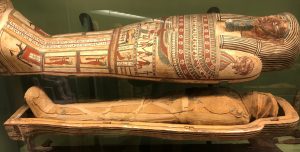
Human remains in museum collections
Human remains may have a personal, cultural, symbolic, spiritual or religious significance for many individuals and groups. This is why museums that manage collections of these kinds bear a particular responsibility. Museums can proceed from the document Good collections management. Guidance for handling human remains in museum collections, when setting up their own policies.
Many of the human remains found in museum collections come from archaeological surveys and were collected pursuant to the Historic Environment Act. Other categories of collections containing human remains come from medical research, as well as ethnographic or ethnological collections.
Collections that have been built up for a specific purpose may have been used for other purposes throughout the ages, up to the present day. The reasons why human remains have become a part of museum collections have varied over the centuries, and to an extent this is linked with which scientific disciplines were dominant at the time when they were collected. To create a context surrounding the remains, it is essential to understand the context in which they were collected.
Human remains in museum collections are used primarily for research, teaching and exhibition purposesnowadays. For researchers working with archaeology and osteology, for example, access to museum collections is frequently a prerequisite for their work. Such research is a vital source of information on factors such as:
• human development, adaptation and genetic context
• demographics and health status
• diet, growth and activity patterns
• diseases, medical interventions and causes of death
• burial condition and customs
• cultural variations in respect of how the body and parts of the body were used.
Every museum should set up its own policy documents and procedures suitable for its own museological needs and conditions. Regarding human remains, museums can proceed from The Swedish National Heritage Board’s document Good collections management. Guidance for handling human remains in museum collections.
See also the supporting document Good collections management: Guidance for managing the return of cultural objects.